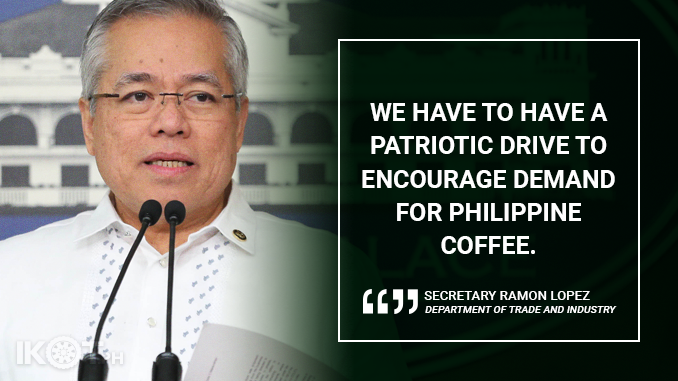While the Philippines consumes as much coffee as countries such as the United States, Brazil, Japan, and the European Union, the country is also looking to be one of the top producers of top-grade coffee around the world.
To make this a reality, President Rodrigo Duterte last March 7, 2017 signed the Philippine Coffee Industry Roadmap 2017-2022 to boost the country’s domestic coffee output in the next five years—a huge lift for coffee farmers, producers, and traders.
Department of Trade and Industry (DTI) Secretary Ramon Lopez said that the trade department is working closely with the Department of Agriculture (DA) to ensure that the Philippine Coffee industry would be at par with the world’s top producers such as Brazil, Vietnam, Columbia, Indonesia, and Honduras.
“We have to have a patriotic drive to encourage demand for Philippine coffee. We are encouraging local producers to expand coffee production to create the demand,” said Sec. Lopez.
We are encouraging local producers to expand coffee production to create the demand.
The Philippine Coffee Industry Roadmap 2017-2022 will guarantee a coffee industry that is cost-competitive, aligned with global quality standards, reliable and environment-friendly, which will provide sustainable benefits to farmers, processors, traders, and exporters, and attain food security and poverty alleviation.
Coffee is the second most traded commodity in the world and is grown in 50 countries along the equatorial zone called “The Bean Belt,” which is located between latitudes 25 degrees north and 30 degrees south. Interestingly, the Philippines lies within the Bean Belt.
Due to this advantageous location and favorable, although tropical, climate, the country produces four varieties of coffee including Robusta, Arabica, Excelsa, and Liberica.
According to Lopez, the current coffee output of the Philippines is pegged at 37,000 tons a year but with the Philippine Coffee Roadmap, the country is expected to raise the coffee production to 214,626 metric tons by 2022. This will bring the country’s coffee self-sufficiency level to 161% from the current 41.60%.
The Philippine Coffee Roadmap would also make available 213,788 hectares of area planted with coffee nationwide, translating to a huge yield of one ton of coffee beans per hectare—a huge discrepancy from the usual 0.33 ton per hectare. The task of implementing the roadmap falls on the Philippine Coffee Council.
Lopez is optimistic that the country will be able to achieve this feat especially with DTI assisting the coffee industry, which is one of the priority sectors of the agency.
“Through DTI’s 7Ms (Mindset change, Mastery, Mentoring, Money, Machine, and Models), we will continue to provide enabling mechanisms to empower coffee farmers and help in addressing the challenges in the industry,” Sec. Lopez added.
Data shows that Vietnam is the highest exporter of coffee green beans to the Philippines. Filipinos are also fifth among the highest consumers of coffee behind EU, US, Brazil, and Japan. Similarly, the Philippines is the top importer of soluble coffee and fourth total importer in the world.
As far as coffee production is concerned, the gap between coffee demand and production is widely noticed with demand for coffee is at 90% and imports amounting to PhP 12 billion. The demand is still increasing with expanding consumption based among younger generation.
Currently, the top five regions in producing coffee are SOCSKSARGEN (Region 12) with 25,100.77 metric tons, Davao with 11,429.78 metric tons, Autonomous Region of Muslim Mindanao (ARMM) with 10,341.59 metric tons, Northern Mindanao with 5,604.95 metric tons, and Western Visayas with 4,356.25 metric tons.
With the Philippine Coffee Roadmap as guide, the trade and agriculture departments together the private sector, and other coffee stakeholders held last March 20-21, 2018, the 3rd Philippine Coffee Conference in Baguio City and presented the coffee industry’s performance on the first year of the implementation of the roadmap.
The conference also discussed among other topics, the strategies to achieve the goals of the Philippine Coffee Roadmap, trends in coffee brewing methods, quality coffee farming of arabica and fine robusta, retailing a coffee business, financing for coffee business, and coffee business models.


